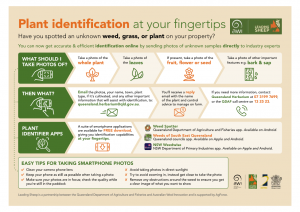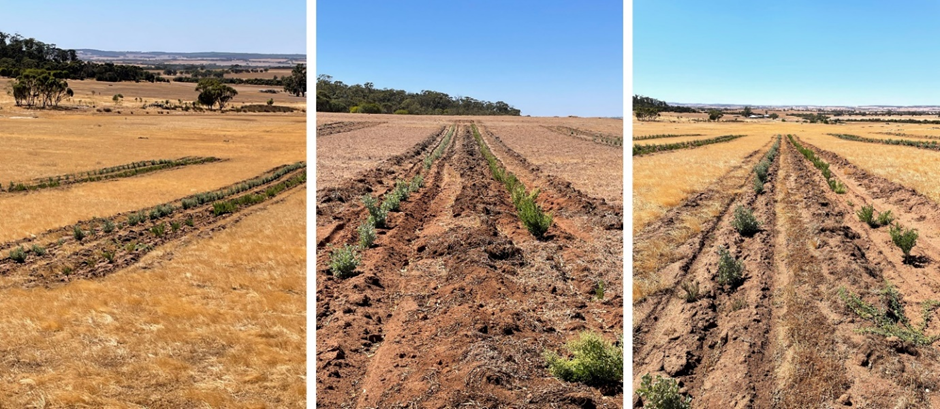- Quick picks: eID, weeds & wool quick picks plus diving into heat stress
- Deep dive – New research into heat stress in sheep
- Upcoming Leading Sheep events
- Upcoming events
- Podcasts, eBulletins and surveys
Quick picks
Electronic identification (eID) support. The Queensland Government has announced the support scheme for Queensland sheep and goat producers, saleyards, processors and livestock agents implementing mandatory individual eID. Of note is a 50% rebate of up to $1600 (per Queensland Property Identification Code) to sheep and managed goat producers for eID readers and tags. Click here for more information about the rebate, tags and important dates.
Weed wise. If you’ve got plants popping up you haven’t seen before, identify them by sending photos to industry experts, using plant identification apps or contact your local Leading Sheep team. Click here to view our guide on taking clear plant photos and where to send them.

The Yarn: China and Aussie wool. In the latest episode of this podcast, AWI/Woolmark’s Country Manager Jeff Ma discusses why Chinese demand for Merino wool remains strong, popular clothing styles for the fibre and a different approach to marketing wool to younger consumers.
Happy ewes, happy you. How are your ewes looking as they approach lambing? Condition score 3 is the target for ewes to improve their chances of weaning a lamb. Good nutrition (e.g. an improvement in one condition score after 90 days gestation) can improve birth weight by 0.5kg and therefore lamb survival. Click here to learn more about how to body condition score and here for options to give your ewes and lambs the best chance.
Support for mandatory NWD. AWEX’s Industry Consultative Committee has announced unanimous support in making the National Wool Declaration (NWD) a condition of sale, based on industry research following the October 2023 review. Several issues need addressing before next steps towards implementation, but processors, exporters and retail brands are confident in the NWD for transparency and traceability. Read more here.
Finding a use for waste wool. Have you tried using your wool in the garden? Save waste wool from shearing and use it as mulch to improve moisture retention, regulate soil temperature, deter pests and provide a slow release of nutrients. Wool pellets have the advantage of shelf stability, the ability to be incorporated into the soil at depth and a wider range of application (for lawns, pot plants etc.), but it’s pretty hard to look past the leftover wool in the shed!
Blackall wool processing plant. Designs for a proposed wool processing plant at Blackall are finalised, with a call for investors to be made by mid-March. The scouring plant, which will require a $43 million investment, could be up and running within two years. It could employ between 45 and 60 people, processing 14 million kilograms of greasy wool per year and reducing logistics through wool transported direct from farm. Further advantages are possible if investment extends to a top-making facility. Read more from Queensland Country Life and Queensland Wool Processors.
Discounted registration rates for wool producers. The annual International Wool Textile Organisation Congress will discuss opportunities for wool, product innovations, manufacturing insights, sustainability and traceability. To encourage woolgrowers to take up the opportunity to connect with global players in the supply chain, a discounted rate of $500 + GST is available to 100 wool levy payers. Register early here. The congress will be held in Adelaide from 15 to 17 April.
Deep dive – New research into heat stress in sheep
Meat & Livestock Australia (MLA) funded research to review the impact of heat stress on sheep reproductive performance. Published in 2021, the research concluded that throughout pregnancy, prolonged exposure to temperatures of more than 32 oC reduces lamb birth weight and, in turn, lamb survival.
There is additional evidence to suggest that the impact of heat stress on reproduction can persist for generations through changes to DNA. This makes it an important topic in Queensland, where most sheep are produced in regions where 32oC is considered a mild spring day. You might find yourself throwing up your arms and thinking there’s not much to be done about this, but remember to focus on what you can control… more on this later.
Following this review, MLA commissioned two projects through the Sheep Reproduction Strategic Partnership (SRSP) to investigate:
- Heat stress in ewes
- The design, establishment and benefits of edible shelter to improve lamb survival and whole-farm profitability.
The first project aims to demonstrate how shade/shelter minimises temperature stress to improve the welfare and production of sheep on commercial farms. The treatments range from minimal to adequate to ample shade, with ewes fitted with GPS (see image below), activity and proximity loggers and rumen bolus internal temperature loggers.

Researchers have found that Merinos have adapted their behaviour to prevent heat stress even when the threshold of the temperature-humidity index is exceeded. To stave off heat stress Merinos have been observed to pant, seek shade, drink more, shift their activity to cooler times of the day (i.e. foraging at night) and seek out areas of the paddock with increased airflow. Furthermore, evidence suggests that over time producers have selected for heat-tolerance in their Merinos through the culling of ewes with a poor reproduction record.
The second project is investigating the impacts of various edible shelter belts on the behaviour, physiology, welfare and survival of sheep and the nutritional benefit of the added feedbase. See below images of newly planted shelter belts. Information from this research is expected to inform recommendations for the development of shelter in sheep enterprises.

Given that heat is a factor of Merino production in Queensland, what can you control with regards to reducing heat stress?
- Stock require night-time temperatures to drop below 24oC for 6 to 8 hours before 3am for the day’s heat to dissipate. Heat events lasting between one and four days can impact ewes and rams. Avoid working stock during and immediately after heatwave events to give animals time to dispel accumulated heat.
- Ensure stock have good access to water (both quantity and quality).
- Particularly for ewes approaching joining or in late gestation, use best shaded and watered paddocks.
- If stock must be moved, consider even earlier starts or later finishes to give sheep the best chance of avoiding stress.
- If stock must be in yards, consider reducing the density of sheep in pens to allow for airflow.
- Understand that for rams, the impact of heat events will be seen 2 to 4 weeks after the event. They should recover in about 7 weeks.
- Know how your flock is performing so you know where to put the effort it. Is heat a problem in your flock?
Data from Queensland enterprises is always appreciated. If you would like to contribute to this valuable industry research please fill out the shade and shelter survey (https://www.surveymonkey.com/r/Shade_and_Shelter). Additionally, if you would like to investigate the possible impact of heat waves and climate on your enterprise please contact your climate mate Vicki Mayne (southwest and central Queensland) or John McLaughlin (Charleville).
If you would like to learn more, check out the MLA Shade and Shelter project, this Feedback article (page 14) or the 2021 review paper mentioned earlier.
Article written by DAF Extension Officer Millie Sheales. Images from MLA.
Upcoming Leading Sheep events
Making eID work for you: Dirranbandi
- Tuesday 12 March 2024, learn more and view the flyer here.
- Don’t miss out! Register here.
- Featuring Anthony Shepherd, Sheepmatters
Making eID work for you: Cunnamulla
- Wednesday 13 March 2024, learn more and view the flyer here.
- Don’t miss out! Register here.
- Featuring Anthony Shepherd, Sheepmatters
Wormboss workshop: Goondiwindi
- Thursday 21 March 2024, learn more and view the flyer here.
- Don’t miss out! Register here.
Wormboss workshop: Terrica Woolshed
- Friday 22 March 2024, learn more and view the flyer here.
- Don’t miss out! Register here.
Leading Sheep Forum & Dinner, Longreach
- Friday 22 March 2024, learn more and view the flyer here.
- Help us out by registering early! Register here.
- AWI CEO John Roberts will be involved in a Q&A session during the evening. Bring your questions!
Upcoming events
- 13 March. Western QLD Grazing Studies & Solutions for the Future, Longreach. Delivered by GroWQ. For more information and to register click here.
- 13 March. Agribusiness Summit Field Day, Goondiwindi. Delivered by Macintyre Ag Alliance. For more information and to register click here.
- 16 March. Farmer First Aid Training, Blackall. Delivered by GroWQ. For more information and to register click here.
- 21 March. Bet on your books, Wallumbilla. Delivered by ConnectAg. For more information and to register click here.
- 22 March. Bet on your books, Noonga. Delivered by ConnectAg. For more information and to register click here.
- 16-18 March. RCS Grazing Clinic, St George. Delivered by RCS. For more information and to register click here.
- 23 March. QLD Wool Forum and WoolClip workshop. Delivered by AWEX. For more information and to register, RSVP to m. 0468 533 529 with name and number attending.
- 20 April. Grass Growers Ball, Longreach. Delivered by GroWQ. For more information and to register click here.
- 10-12 May. State Sheep Show, Blackall.
Podcasts, eBulletins and surveys
- Around the Camp Leading Sheep podcast
- AuctionsPlus Sheep Results and Catalogue
- AWI Beyond the Bale magazine
- AWI The Yarn podcast
- AWI Weekly Wool Market Report
- Farm Biosecurity News
- MLA Prices and Markets
- Sheep Producers Australia News
- Wool Producers Australia News

